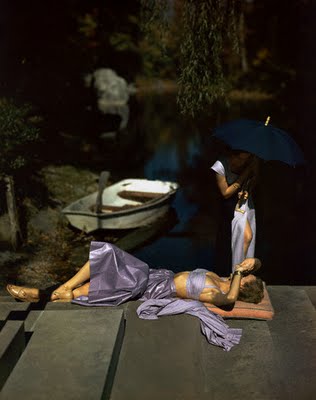Something phenomenal happened last Thursday, a previous post of mine generated over 3000 hits in one day, the said post is here. The preferred search word was 'Jean Shrimpton now'. The reason for this sudden flurry of interest was the airing of John McKays film, 'We'll Take Manhattan' on Britains BBC 4. The story centres around Bailey and Shrimpton's ground breaking 1962 photo shoot in New York, their love affair and the struggle to persuade stuffy old British Vogue to try something fresh, young and different.
I watched and it was a highly enjoyable frothy drama, which perfectly fits in with the trend for recent history period dramas and the vintage clothing revolution. I especially enjoyed Helen McCrorys characterisation of the slightly neurotic British Vogue fashion editor Lady Clare Rendlesham and the small appearance of Diana Vreeland, I would have liked to have seen more of her! For those of you reading overseas, here is the trailer, I am sure it has already been sold abroad and if it does not appear on your screens soon, no doubt it will be on DVD.
Another post that received a flurry of hits is here, a post about Jean and her modelling contemporaries and what happened to them after the sixties.
In pre 1960's Britain most models were patrician beauties, plucked from the families of the landed gentry, it seems even a well brought up, middle class young lady from the home counties didn't quite cut the mustard. And if that was not enough, a cheeky, working class, young photographer wanted to photograph her amidst a raw, gritty environment and pose her naturally. Below are Baileys photographs of seventeen year old Jean Shrimpton which caused such a fuss but contributed to the sixties youth quake liberation and the blurring of the social classes in sixties Britain.
And later... a polished Jean Shrimpton and one of the greatest models of all time.
Following the film was an excellent documentary on David Bailey 'Six Bars to the Beat' (how I love BBC 4, so glad this channel was saved from being axed as part of the BBC cuts). Crusty, weasy, sniggery old Bailey, he is now 73. At times he can be toe curlingly crude but I couldn't help but like him, refreshingly non politically correct and he does talk a lot of sense. Talking heads included, Jerry Hall, Catherine Deneuve, Mary Quant and Catherine Bailey.
In the documentary Bailey declared that the only model that has the same qualities that Shrimpton had is Kate Moss, Bailey went onto to discuss how their brand of beauty is universally appealing, I can't remember his exact words but I think he mentioned how they could be the girl next door and how they are not classical beauties but beautiful. I thought I would explore this...
Just like Jean Shrimpton but for very different reasons Kate Moss did break the mould when she bounced onto the scene in 1989, her story is well known and has become fashion legend, when she was 14 years old she was spotted at JFK airport by Storm model agency founder and owner Sarah Dukas, controversy followed, too young, too thin etc. Controversy has been following Kate ever since but she was completely different to the intimidatingly beautiful, curvaceous, Amazonian supermodels who were dominating the catwalks, glossies and pop videos of the late eighties and early nineties.
Peter Lindeberghs photograph of the supermodels, British Vogue cover January 1990
Corinne Days photoshoot of fifteen year old Kate Moss for The Face magazine
Polished Kate, heading towards 40, enduringly photogenic, Mario Testino for Vogue August 2011
To further investigate Baileys claims of the similar appeal of Kate and Jean I thought it may help to see them both on film...
Young Kate auditioning for a L'Oreal commercial
Jean Shrimpton in the 1967 film privilege
There is no doubt that both women are beautiful, with incredible bone structure and both ridiculously photogenic. I wonder, will they be making a film about Kate Moss in fifty years time? As there is a sculpture in her image cast in gold and Lucien Freuds painting of her sold for 3.93million pounds, not to mention her well documented rock and roll lifestyle...I think it's a certainty.
If your still hanging in there you can see and hear more of Baileys thoughts here...





























































